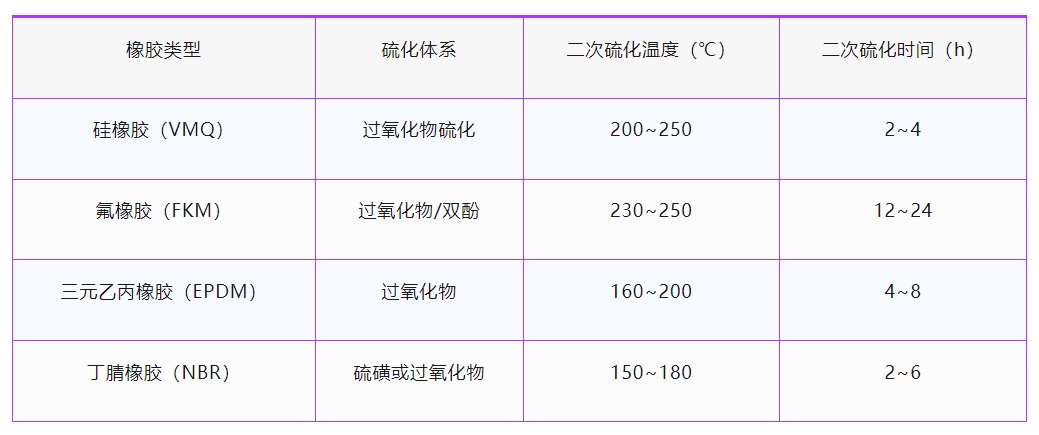Why is secondary vulcanization indispensable for high-end rubber products? An in-depth analysis of its secrets!
Multi-line text content element
HTML language content can be parsed after rich text content is bound to data
Release time:
Apr 29,2025
Rubber vulcanization is a process that transforms linear or branched rubber molecules into a three-dimensional network structure through chemical cross-linking, thereby improving the mechanical properties, heat resistance, and chemical corrosion resistance of the rubber. However, in certain applications, single vulcanization may not meet the performance requirements of the final product, necessitating secondary vulcanization (Post Cure or Secondary Vulcanization). This article will detail the conditions under which rubber requires secondary vulcanization, and analyze its advantages, disadvantages, and influencing factors.
I. Under What Circumstances Is Secondary Vulcanization Required?
Secondary vulcanization is typically applicable to high-performance rubber materials, such as silicone rubber, fluoroelastomer, ethylene propylene diene monomer (EPDM), nitrile butadiene rubber (NBR), and certain special synthetic rubbers. Its main applications include:
1. Enhancing Crosslink Density and Optimizing Physical and Mechanical Properties In some rubber systems, such as peroxide vulcanization and certain amine vulcanization systems, the degree of crosslinking during initial vulcanization may be insufficient. Secondary vulcanization can further promote crosslinking, improving the material's strength, wear resistance, and resilience. For example:
• Peroxide-vulcanized silicone rubber and fluoroelastomer, secondary vulcanization reduces residual peroxide and volatile byproducts, forming a more stable chemical structure.
• Certain special applications of natural rubber and chloroprene rubber, such as high-load fatigue-resistant products, secondary vulcanization helps improve elasticity and aging resistance.
2. Removing Low-Molecular-Weight Substances and Improving High-Temperature and Chemical Corrosion Resistance During rubber vulcanization, some vulcanizing agents or accelerators may produce low-molecular-weight byproducts, such as:
• Ketones, alcohols, or acids produced by peroxide vulcanization.
• Residual volatile siloxanes (such as D4, D5 cyclics) in silicone rubber.
• Unreacted small molecules or decomposition products remaining after fluoroelastomer vulcanization, which may affect the resistance to media performance. These low-molecular-weight substances may be released at high temperatures or during long-term use, leading to a decline in rubber material properties. Therefore, secondary vulcanization can remove these byproducts, improving the material's temperature resistance, oil resistance, and corrosion resistance.
3. Reducing Compression Set and Improving Long-Term Stability In certain dynamic or high-load conditions, such as aerospace, automotive seals, and industrial seals, rubber products need to maintain elasticity and shape for extended periods. Single vulcanization may cause significant compression set in the rubber after being subjected to pressure. Secondary vulcanization can optimize the orientation of rubber molecules, improving their long-term deformation recovery capacity.
4. Improving Aging Resistance and Reducing Oxidative Degradation Rubber that has undergone secondary vulcanization has a more stable crosslinked structure and is less susceptible to oxidative degradation.
For example:
• Fluoroelastomer (FKM) is prone to oxidation at high temperatures; secondary vulcanization can reduce free radicals, improving heat resistance and chemical stability.
• Silicone rubber may release small molecules at high temperatures, accelerating aging; secondary vulcanization can significantly reduce this problem.
5. Eliminating Processing Stress and Improving Product Dimensional Stability Complex or large rubber products (such as rubber roller coating, rubber-metal bonding parts) may develop internal stress during vulcanization. Secondary vulcanization allows the rubber to further solidify while releasing residual stress, reducing deformation and improving dimensional stability.
II. Advantages and Disadvantages of Secondary Vulcanization:
1. Advantages of Secondary Vulcanization:
• Increases crosslink density, enhancing rubber's mechanical strength, wear resistance, and heat resistance.
• Removes low-molecular-weight substances, reducing odor and improving the material's resistance to media and safety.
• Reduces compression set, improving the reliability of seals and gaskets in long-term use.
• Optimizes aging resistance, reducing degradation in high-temperature or oxidizing environments.
• Improves dimensional stability, especially for precision products or rubber parts with complex shapes.
2. Disadvantages of Secondary Vulcanization:
• Increased process complexity, requiring additional time and equipment, increasing production costs.
• Increased energy consumption; secondary vulcanization is usually performed at higher temperatures, requiring additional energy.
• Not suitable for all rubber systems; for example, some vulcanization systems may degrade during secondary vulcanization.
• May affect elasticity; for some rubbers, excessively high crosslink density may lead to increased brittleness and reduced flexibility.
III. Common Process Parameters for Secondary Vulcanization:
1. Temperature and Time Control:
• The temperature and time of secondary vulcanization depend on the rubber material and vulcanization system; common parameters are as follows:

2. Influencing Factors:
• Type of vulcanizing agent: Rubber vulcanized with peroxides usually requires secondary vulcanization more than sulfur vulcanization systems.
• Thickness of the rubber product: Thicker products may require longer secondary vulcanization times to ensure complete internal crosslinking.
• Environmental conditions: such as humidity and oxygen content, which may affect the effectiveness of secondary vulcanization.
Secondary vulcanization is an effective process method that plays a significant role in improving the performance of rubber materials, especially for high-performance rubbers (such as silicone rubber, fluoroelastomer, EPDM, etc.). Its main functions include increasing crosslink density, removing byproducts, improving durability and stability, but it also brings additional costs and process complexity. Therefore, in actual production, the need for secondary vulcanization should be comprehensively considered based on material characteristics, product use, and production costs, and its process parameters should be optimized to achieve optimal performance and economic benefits.
Recommended Content
Share

